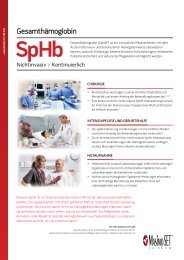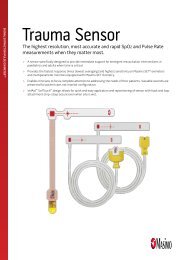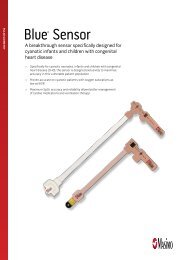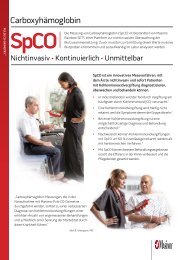Carboxyhemoglobin - Masimo
Carboxyhemoglobin - Masimo
Carboxyhemoglobin - Masimo
Create successful ePaper yourself
Turn your PDF publications into a flip-book with our unique Google optimized e-Paper software.
In this case, the CO exposure of the hemolytic patient imitated CO production from anesthetic breakdown. In<br />
reality, analysis of the patient’s blood estimated CO production of 257 ml per 24 hours. Normal endogenous<br />
CO production is approximately 10 ml per day. 18 A mathematical model of CO uptake 19-21 predicts a COHb<br />
concentration between 5.6 percent and 7.3 percent using this rate of hemolysis. If this patient had received an<br />
anesthetic through a closed breathing circuit, the oxygen binding capacity of hemoglobin could have become<br />
an additional 23 percent saturated with CO during the 6-hour procedure because none of the endogenously<br />
produced CO would be removed. The model predicts that closed-circuit anesthesia during an episode of<br />
hemolysis may dangerously increase COHb concentrations. 22 As such, anesthesiologists should be aware of all<br />
sources of CO in the perioperative period and maintain constant awareness of the patient’s COHb status.<br />
2. Inhaled Nitric Oxide<br />
Inhaled nitric oxide (iNO) is occasionally used to improve arterial oxygenation in patients with the acute<br />
respiratory distress syndrome (ARDS). 23 Inhaled NO induces selective vasodilation in pulmonary vessels to relieve<br />
hypertension. The use in ARDS cases has brought to light a potential pathophysiologic mechanism linking iNO,<br />
methemoglobin (MetHb), and carboxyhemoglobin (COHb). The withdrawal of iNO in this study resulted in a parallel<br />
decline in MetHb and COHb levels. Due to the negative influence of COHb on the oxygen-carrying capacity of the<br />
blood, its iNO-induced increase (through stimulants of hemoxygenase inductions) cancelled out the slight benefit<br />
of iNO on arterial oxygenation. A case report published in 2004 demonstrated a correlation between iNO and<br />
COHb. 24 The authors do propose that not only MetHb but also COHb levels be monitored if iNO is administered<br />
during the course of ARDS, since even low levels of COHb may potentially offset any benefit of iNO.<br />
3. Sodium Nitroprusside<br />
whitepaper<br />
Sodium nitroprusside is the most widely used vasodilator drug in critically ill patients. 25-28 The drug is often<br />
administered intravenously to patients who are experiencing a hypertensive emergency and to produce controlled<br />
hypotension (low blood pressure) in anesthetized patients during surgery. Sodium nitroprusside breaks down<br />
in the blood and releases nitric oxide (NO) which enters the muscle cells in the walls of the blood vessels and<br />
causes them to relax. When the muscles relax, the vessels become wider and the blood pressure decreases.<br />
The most important toxic effects of sodium nitroprusside are cyanide poisoning, thiocyanate toxicity, and<br />
methemoglobinemia. 29 Like the reaction triggered by sepsis and pulmonary inflammation, research suggest that<br />
NO donors, such as sodium nitroprusside, can induce heme oxygenase-1, and produce CO by breakdown of<br />
heme molecules. 30-32<br />
One study examines the cases of four pediatric heart transplant cases. 33 The patients showed a moderate increase<br />
in COHb level after nitroprusside administration, and in three of these cases the withdrawal of the drug led to the<br />
normalization of COHb level. If in fact prolonged treatment with moderate or high doses of sodium nitroprusside<br />
can produce carboxyhemoglobinemia in children after heart transplant, specific medical management after<br />
pediatric heart transplant should include frequent measurement of COHb. Even low levels of carbon monoxide<br />
bound to hemoglobin in cardiac compromised patients can be lethal, starving the tissues of oxygen due to<br />
functional anemia, poor perfusion, cardiac output compromise, and suboptimal oxygen delivery mechanisms.<br />
Accepted standards of patient monitoring associated with nitroprusside administration include analysis of MetHb<br />
concentrations. 34 Research suggests that COHb levels should be evaluated as well. Current blood analysis devices<br />
that measure CO-Oximetry in each blood gas sample permit diagnosis of moderate COHb elevations that probably<br />
would not have been discovered in the past. With noninvasive and continuous Pulse CO-Oximetry, results are<br />
faster and less resource-intensive than ever before. Of significant importance is the ability to trend the changes in<br />
COHb over time (see Figure 1), and view the trend at will. Days of trend data are saved for retrospective analysis<br />
of subtle changes in COHb (and when necessary, MetHb). Without the continuous assessment, the task of<br />
associating subtle changes in the dyshemoglobins is daunting, and impossible using traditional laboratory CO-<br />
Oximetry. As well, the trend value allows the patient to serve as their own baseline. At the beginning of the trend<br />
period, carboxyhemoglobin by Pusle CO-Oximetry (SpCO) may measure 1.0 percent, but with a course of sodium<br />
nitroprusside treatment, or following the transitions into SIRS, the clinician may note trends in elevation of COHb,<br />
and interact accordingly with the patient to achieve the desired outcome.<br />
5






